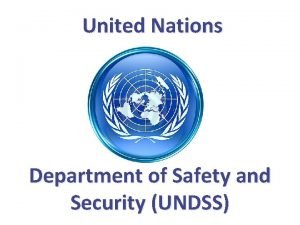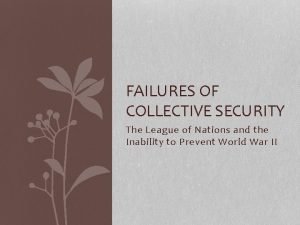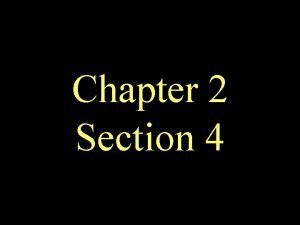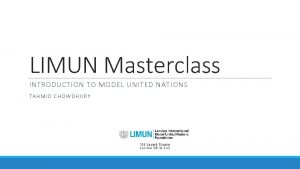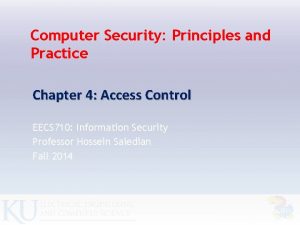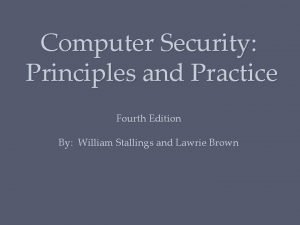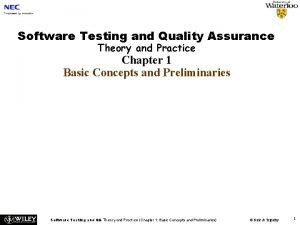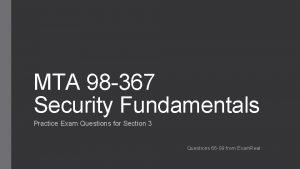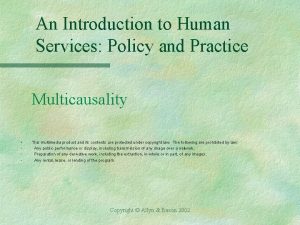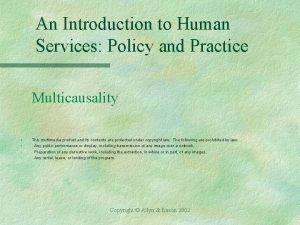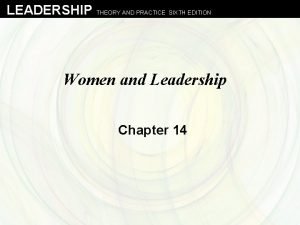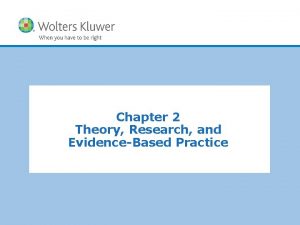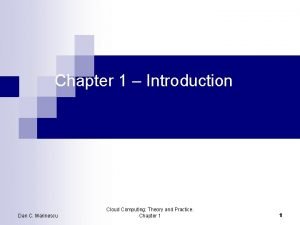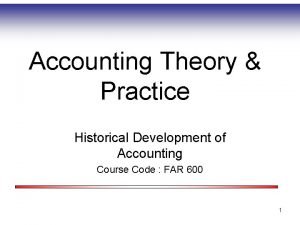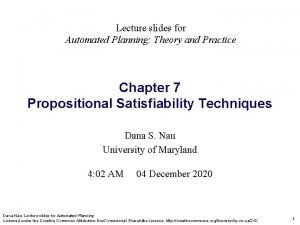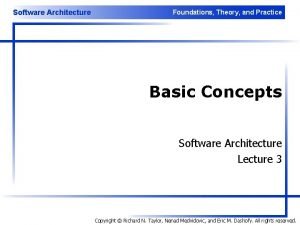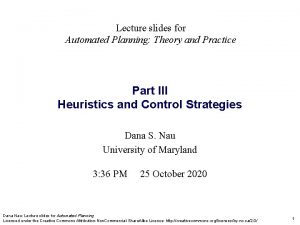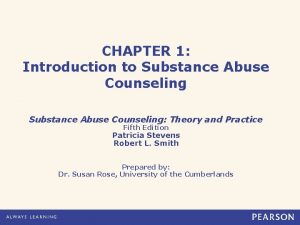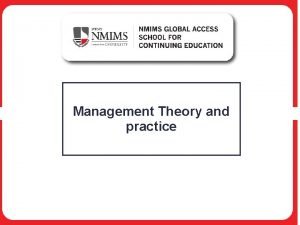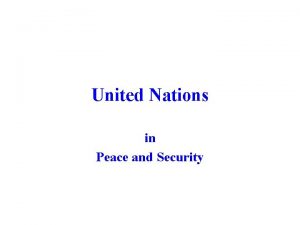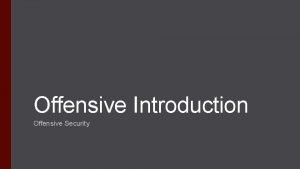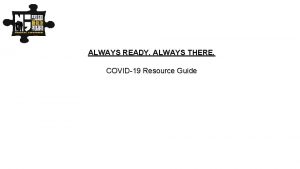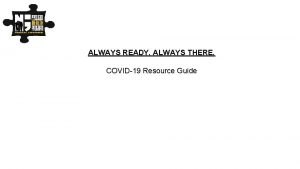SECURITY THEORY AND PRACTICE Introduction Nations have always







































































- Slides: 71

SECURITY THEORY AND PRACTICE

Introduction � � Nations have always been preoccupied with security and preserving it remains a fundamental duty of national leaders. States continue to face the dilemma of choosing between security on the one hand, and economic and social development on the other, when allocating their scarce resources.

The Many Faces of Security

The Many Faces of Security � What Is National Security? � Security has many different aspects that change over time and between environments. Physical Economic Environmental Cultural.

� Like persons, states face different security problems and give priority to different components of security. Before and during the Cold War, the military aspects of security received the most attention in international relations. � With the end of the Cold War, leaders have come under increasing pressure to address the economic, environmental, and cultural aspects of security. �

External and Internal Threats � Most states face both internal and external threats to their security � The mix of internal and external threats determines a state's security environment. � Internal and external threats are often interrelated, and � Overreaction other. to one can increase risks from the

� Transnational threats to security are coming to the top of many states' agendas � International organized crime � Terrorism � AIDS.

� However, expansion of the definition of security to include every problem a nation faces risks sweeping increases in the size and power of governments � “National Security" is a favored excuse for restriction, suspension, or revocation of civil rights.

Subjective v. Objective Aspects of Security � To a great degree, security is a subjective perception or feeling � Historically, some states have felt threatened for reasons that other states found hard to understand Ex. USSR under Stalin � Others did not recognize threats and fell victim to surprise attack Ex. the United States in 1941.

� As a nation's power increases, one might expect it to feel more secure � But history shows that the reverse More power plus greater perception of insecurity often occurs �Ex. United States during the Cold War.

A Working Definition of Security � The definition of security: �A condition in which the sovereignty and territorial integrity of a state are guaranteed.

� In the anarchic international system, this condition has often been very difficult for states to achieve � Many states face threats and have experienced military conflicts. � Universal security is theoretically possible but not likely � States with growing populations and economic needs will seek more scarce resources, which creates the potential for conflict and raises the risk of armed aggression.

The Security Dilemma Revisited

The Security Dilemma Revisited � The effectiveness and utility of a state's security measures are always uncertain � Defensive efforts may discourage an aggressor, or they may backfire by encouraging other states to arm themselves.

� � Countries thus find it difficult to escape the vicious cycle of the security dilemma Security Dilemma Measures a state takes to increase its own security are likely to decrease the security of other states � Other states are then likely to respond, and the security of all is diminished.

Military Power

Military Power � Military power consists both of "hardware" and "software“ � Hardware: Weapons and Equipment � Software: Personnel, training, and leadership Military power depends greatly on economic power States can be stronger in one than the other but will then face strategic vulnerabilities. �

Weapons of Mass Destruction � � Strategic nuclear forces are designed to attack targets, including cities, at long range Tactical nuclear weapons are short- or medium-range weapons designed to be used primarily against military targets.

� The United States and Russia have the largest nuclear inventories � In addition to the eight declared nuclear powers (India and Pakistan joined "the club" in 1998 and North Korea joined in 2005), Israel is generally believed to possess nuclear warheads, though they have not stated this openly, and other states have clandestine programs to develop nuclear weapons.

� Other states possess different weapons of mass destruction; � Chemical and biological weapons are possessed by some states regardless of the international conventions.

Military Personnel � Overall number of military personnel indicates the strength of a nation's ground, naval, and air forces but � � Some states rely on alliances for their security � � Offers no indication of qualitative factors such as training and leadership. Ex. Japan Whereas others have large reserve forces that can be mobilized quickly in a crisis.

Logistics and Power Projection � � Logistics – The art and science of delivering forces and supplies to the right place at the right time Power projection – the ability to apply military force beyond a state's borders. � States with large naval forces and good access to sea lanes have an advantage in power projection � States that lack these are at a disadvantage, despite their overall military power.

Qualitative Factors: Equipment, Training, and Morale � Although there are useful numerical indicators of military power, qualitative components are also important � Numbers fail to reveal Accuracy Lethality Reliability of weapons.

� The skills and motivation of soldiers and ability of their leaders have been crucial in many conflicts but can’t be measured.

� Small, highly trained, professional forces can be far more capable than large, poorly motivated, and incompetently officered armies.

Soft Power � Coined by Joseph Nye, Jr. � Soft power – a state’s ability to get other countries to do what it wants.

Strategies for Security

Strategies for Security: Deterrence � Deterrence attempts to prevent war by discouraging a potential aggressor � Usually accomplished by threatening retaliation or punishment so that the likely costs of attacking will exceed any anticipated gain.

� Three requirements must be met for the success of a deterrent strategy � Capability � Commitment � Credibility.

� Deterrence is commonly associated with nuclear weapons, but it is an ancient strategy � May be used with conventional weapons � Is used on the personal level as well

Types of Deterrence � � General deterrence is a long-term strategy discouraging serious consideration of attacks or challenges to vital interests Immediate deterrence is a response to a specific and explicit challenge or threat to attack. Primary deterrence seeks to dissuade attacks on a state's own territory Extended deterrence seeks to dissuade attacks on a state's allies or external interests.

Defense � Defense attempts to reduce an enemy's capability to damage or take something away from the defender � Defense minimizes damage from an attack and denies territory and other resources to the attacker.

� Although deterrence is primarily psychological defense is primarily physical.

Compellence � Compellence attempts to force an adversary to reverse or undo some damaging action that has already been taken � It’s almost always more difficult than deterrence because you must force an opponent to give back something that has successfully been gained. Ex. The Cuban Missile Crisis is the most cited case of compellence success.

Requirements for Deterrence: Commitment � The first step in deterrence: � Announcing a commitment to punishing an attacker, or "drawing a line in the sand. " � Deterrence commitments must be definite and specific � Ambiguity may encourage challenges or attacks.

Capability � � A state must possess the capability or means to retaliate in order to deter an attack successfully. Unlike credibility, states may choose to keep their capabilities ambiguous � Potential attackers might believe the defender's capability is stronger than it actually is Ex. Israel's refusal to officially reveal its nuclear capabilities.

Credibility � A state must convince the aggressor of its resolve to carry out a deterrent threat � The commitment to punish must not sound like an empty threat or bluff. � Credibility may depend on reputation, past behavior, and image.

� The destructive power of nuclear weapons creates a credibility problem: � Would the defender be willing to see millions of people, on both sides, die in a nuclear war?

� Even when the defender demonstrates commitment, capability, and credibility, deterrence can still fail. � The attacker may calculate that the benefits of attacking exceed the likely costs of punishment.

Criticisms of Deterrence � Human beings are not always rational. � States and leaders may not base their actions in rational thought � The information available to both sides may not be accurate or reliable.

� Opponents rarely understand each other perfectly � Even if the defender does everything right, the attacker may still fail to "get the message. " � A defender's resolve can be misperceived if the attacker is: � Strongly intent on taking the action or � A challenger might believe the defender is bluffing. Challengers can underestimate their adversary's capabilities and mistakenly expect an easy victory.

Defensive Weapon Systems � Paradoxically, defensive weapons systems that destroy incoming missiles are destabilizing because they reduce the effectiveness of mutual deterrence.

� An antiballistic missile system was proposed during the Cold War � The Strategic Defense Initiative (SDI, or "Star Wars"), proposed in the 1980 s First intended to create a "peace shield" against incoming missiles over the United States.

Technology and Security

� Military technology has always been an important component of material power. � Technological breakthroughs can result in the introduction of new weapons that give a state or alliance a major, though temporary, advantage EX. U. S. development of the atomic bomb at the end of WW II � A breakthrough can backfire, however, once the opponent copies the new weapon.

� The offense/defense balance can determine the outcome of the military engagement. � At certain points in history, technology made offense dominant Whenever the offense is dominant, wars are more likely to occur �But can be expected to be shorter and less costly. � At other times, technology made defense dominant When defense is dominant, wars are less likely �But tend to be protracted wars of attrition with high casualties. � It is often difficult to determine whether offense or defense is dominant at a particular time, especially if a new technology has just been introduced Misjudging the offense/defense balance, however, can be disastrous.

� Technology can provide the cutting edge, and four trends illustrate how technology is likely to have an even greater impact on security. � The emergence of space A theater of military operations is growing in importance �Reliance of military forces on satellites to locate targets �Track friendly and hostile forces �Transmit information and �Coordinate movements. � The combination of advanced information systems with improved delivery systems make wars deadlier than ever.

� The emergence of information warfare becomes a threat due to the high reliance on computers and instant communication.

Arms Control and Disarmament

� Arms control attempts to manage an arms race � To minimize the danger posed by the security dilemma May or may not involve reducing the level of armaments deployed � Disarmament tries to reduce overall levels of arms as a goal in and of itself.

� The primary goal of arms control is stability � The levels of armament give neither side an incentive to launch an attack or to increase its arms.

Early Efforts at Disarmament � The horrors of WW I prompted a series of arms control and disarmament initiatives � Kellogg-Briand Pact of 1928 Almost all nations agreed to renounce war as an instrument of national policy �Allowed self-defense �Had no enforcement Naval treaties of the 1920 s and 1930 s �Limitations on certain types of warships �Germany was left out of the negotiations �Japan withdrew in 1934.

� After WW II the United States proposed that all atomic energy activities be placed under international control � But this would have made the U. S. a nuclear monopoly Rejected by the USSR.

Test Bans � The Limited Test. Ban Treaty (1963) restricted the United States, United Kingdom, and USSR to underground nuclear testing.

Threshold Test-Ban Treaty � The Threshold Test. Ban Treaty (1974) prohibited U. S. and Soviet tests of more than 150 kilotons in yield.

CTBT � The Comprehensive Test-Ban Treaty (CTBT), prohibits all testing of nuclear explosives � Signed in 1996 by more than one hundred states The U. S. Senate refused to ratify the treaty.

SALT I � The United States and USSR signed the first Strategic Arms Limitation Treaty (SALT I) in 1972. � Put ceilings on land- and sea-based nuclear missiles at existing levels 2347 for the USSR 1710 for the United States �Were to be further reduced in subsequent treaties �Didn’t limit MIRVs.

ABM Treaty � The ABM Treaty limited each side to two ABM sites with not more than one hundred ABMs each Later reduced to one site, and the U. S. system never became operational � Prohibited spacebased ABM systems. �

START � The Strategic Arms Reduction Talks (START) began negotiations during the Reagan administration � Resulted in the first arms control treaties to actually reduce levels of strategic arms. Limited the United States and USSR to 1600 launchers each �No more than 6000 warheads per side.

START II � START II, signed between the United States and Russia Further reduce their strategic nuclear arsenals to between 3000 and 3500 warheads each � Total elimination of MIRVs. � � � The United States ratified START II Russia’s attached conditions, including continued adherence to the ABM Treaty � The United States withdrew from the ABM Treaty Russia no longer considered itself bound by the provisions of START II.

SORT � United States and Russia agreed to the provisions in the Treaty on Strategic Offensive Reductions � Obligated both parties to reduce their arsenals of operationally deployed offensive nuclear weapons to between 1700 and 2200 Treaty is criticized because it does not require either side to destroy the weapons taken out of service.

Intermediate-Range and Tactical Nuclear Weapons � The INF Treaty of 1987 eliminated all U. S. and Soviet nuclear missiles with ranges of between 500 and 5500 kilometers � Marked the first time that an entire class of nuclear weapons had been banned.

� After the breakup of the Warsaw Pact and the reunification of Germany, tactical and battlefield nuclear weapons lost their military utility in Europe � � Between 1991 and 1993, thousands of these weapons were eliminated without formal arms control agreements. Following the demise of the Soviet Union, the successor states agreed to transfer all the tactical nuclear weapons on the former Soviet territory to storage depots in Russia.

Cooperative Threat Reduction � Following the collapse of the Soviet Union, the newly independent states did not have enough funds to safeguard their nuclear material. � International aid was extended to Russia and other former Soviet states through a program called Cooperative Threat Reduction (CTR). Succeeded in removing all nuclear weapons from Kazakhstan, Ukraine, and Belarus and In dismantling almost 6, 000 nuclear warheads, over 750 missiles, and 24 submarines.

� The program is not without its problems � Russia claimed too much money went to American contractors and that � Conversion programs were largely ineffective � American critics claimed that Russia could not account for all of the funds allocated to the programs and � Curtailed access to areas containing weapons and nuclear material.

Nonproliferation Treaty � � � The Nonproliferation Treaty (NPT), which sought to prevent the spread of nuclear weapons, was signed in 1968 and prohibited states that did not have nuclear weapons from acquiring them, and it banned states that possessed nuclear weapons from helping them to do so. Many states with nuclear ambitions at the time refused to sign the NPT (India, Pakistan, South Africa, and Israel); others signed but continued nuclear weapons programs anyway (Iran, Iraq, North Korea). China and France signed the NPT by 1993, but preventing determined states from developing nuclear arsenals is becoming an increasingly difficult problem as demonstrated by the recent cases of Iran and North Korea.

Chemical Weapons, Biological Weapons, and Missiles

Chemical Weapons Convention � Banned the possession, acquisition, stockpiling, transfer, and use of all forms of lethal chemical weapons � Gave signatory states ten years to dispose of these weapons, but Non-signatory states (including Syria and North Korea) continue to maintain these weapons.

Biological Weapons Convention � Banned "germ warfare" weapons � Some states nevertheless continued biological weapons programs (USSR until 1992, Iran, Syria).

Missile Technology Control Regime � Restricts the export of ballistic missile technology

Conventional Arms Control � The developing world has failed to undertake adequate arms control � Partly due to the fact that many developing countries rely on defense expenditures for growth.
 Private security
Private security What is undss
What is undss Always low prices
Always low prices Collective security
Collective security Face of rectangular prism
Face of rectangular prism Why have some nations begun transition to free enterprise
Why have some nations begun transition to free enterprise Introduction to model united nations
Introduction to model united nations Un introduction
Un introduction Security is always too much until the day it is not enough
Security is always too much until the day it is not enough Wireless security in cryptography
Wireless security in cryptography Electronic commerce security
Electronic commerce security Computer security principles and practice
Computer security principles and practice Computer security principles and practice solutions
Computer security principles and practice solutions Computer security principles and practice 4th edition
Computer security principles and practice 4th edition Computer security principles and practice
Computer security principles and practice Japanese fresh fish story
Japanese fresh fish story Recognizing parallel structure
Recognizing parallel structure 1a grammar present simple and continuous
1a grammar present simple and continuous Atoms always have
Atoms always have People have always polluted
People have always polluted Unreserved love
Unreserved love Myeplg
Myeplg Quality assurance theory
Quality assurance theory Compassion theory
Compassion theory Quality revolution
Quality revolution Theory of goodenough and gerhart
Theory of goodenough and gerhart Software testing and quality assurance theory and practice
Software testing and quality assurance theory and practice Quality assurance theory
Quality assurance theory Osi security architecture model
Osi security architecture model Security guide to network security fundamentals
Security guide to network security fundamentals Visa international security model
Visa international security model Electronic mail security in network security
Electronic mail security in network security What is nstissc security model
What is nstissc security model Seven touchpoints for software security
Seven touchpoints for software security Security guide to network security fundamentals
Security guide to network security fundamentals Security guide to network security fundamentals
Security guide to network security fundamentals Introduction to cryptography and network security
Introduction to cryptography and network security Introduction to cryptography and network security
Introduction to cryptography and network security Introduction to cryptography and network security
Introduction to cryptography and network security Mta security fundamentals exam questions
Mta security fundamentals exam questions Sql server security best practice
Sql server security best practice Sip security best practice
Sip security best practice Number theory in cyber security
Number theory in cyber security An introduction to human services policy and practice
An introduction to human services policy and practice Multicausality in human services
Multicausality in human services Theory and practice of histotechnology
Theory and practice of histotechnology The theory and practice of oligarchical collectivism
The theory and practice of oligarchical collectivism Leadership theory and practice 6th edition
Leadership theory and practice 6th edition Jacques p thiroux
Jacques p thiroux Theory research and evidence based practice
Theory research and evidence based practice Dan c. marinescu
Dan c. marinescu Accounting theory and practice notes
Accounting theory and practice notes Coaching theory and practice
Coaching theory and practice Oligarchical collectivism
Oligarchical collectivism Automated planning theory and practice
Automated planning theory and practice Teaching practice chapter 1
Teaching practice chapter 1 What is text linguistics
What is text linguistics Alon global marketing download
Alon global marketing download Evidence based theory
Evidence based theory Daniel tanner 1980 definition of curriculum explanation
Daniel tanner 1980 definition of curriculum explanation Software architecture foundations theory and practice
Software architecture foundations theory and practice Macroeconomics theory and practice
Macroeconomics theory and practice Automated planning theory and practice
Automated planning theory and practice Authentic leadership theory and practice
Authentic leadership theory and practice Software architecture foundations theory and practice
Software architecture foundations theory and practice Global marketing contemporary theory practice and cases
Global marketing contemporary theory practice and cases Jacques thiroux
Jacques thiroux Substance abuse counseling theory and practice
Substance abuse counseling theory and practice Batch sequential architecture
Batch sequential architecture Management theory and practice
Management theory and practice Learning approaches theory and practice
Learning approaches theory and practice Servant leadership northouse
Servant leadership northouse

